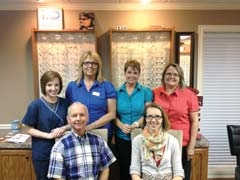Helping Prevent Sports Eye Injuries
Claremore Eye Associates encourages parents to become educated on preventing eye injuries in children who participate in sports.
By: Lorrie Ward | Category: Professional Services | Issue: September 2012

The staff at Claremore Eye Associates (L to R): (Standing) Kristin Kress, Becky Garoutte, Kim Marcotte, Betty Mitchell, (Seated) Dr. Steve Smith and Dr. Lacy Crissup. (Not pictured: Dr. James Stover.)
Sight is one of our most utilized senses; yet it seems to be the one most taken for granted, and our eyes are often the last thing we think of protecting. That’s why Prevent Blindness America has designated September as Sports Eye Injury Prevention Awareness Month, and Dr. Lacy Crissup of Claremore Eye Associates encourages everyone, especially parents with children who are involved in sports, to become educated on how to protect against immediate eye injury and how to prevent long term damage as well.
“According to a report by the American Optometric Association, the majority of sports-related eye injuries are preventable with protective eyewear,” says Dr. Crissup, who cites statistics from the U.S. Consumer Product Safety Commission showing that over 70 percent of reported sports-related eye injuries happen to people under 25, and almost half occur in children under 15. Unfortunately, thousands of these injuries result in permanent loss of sight in the affected eye. Dr. Crissup suggests specific protective eyewear not only for those who don’t need prescription eyeglasses, but also for those who do. “Regular eye glasses are great for daily wear and tear,” she points out. “But they are not designed to protect in high-impact situations.”
Since many sporting events and activities take place outside, protection against ultraviolet light, commonly known as UV rays, is an important consideration when purchasing protective sports eyewear.
Dr. Crissup notes, however, that UV protective eyewear is actually important for anyone who ever goes outside at all – especially children, as UV damage takes place over the long term. “Kids tend to spend more time outside than adults, and their crystalline lens is clearer, allowing more UV radiation to pass to the back of the eye,” says Dr. Crissup. “This makes them more susceptible to long-term effects like cataracts, macular degeneration, and cancer in and around the eyes.” She suggests following the guidelines set forth by the AOA: wear sunglasses or contacts equipped with proper UV protection (blocking 99 to 100 percent of UV-A and UV-B rays), apply sunscreen around the eye area, and if possible, wear a hat for extra shade.
The school year brings more than just the risk of sports injuries when it comes to the eyes, as more time will be spent in front of a computer screen. Many children – and many adults for that matter – suffer from a modern malady, Computer Vision Syndrome, or CVS. The AOA lists the most common symptoms of CVS as the following: eyestrain, headaches, blurred vision, dry eyes, and neck and shoulder pain. “A person might be suffering from uncorrected vision problems that surface when they start working on the computer a lot, such as farsightedness, astigmatism, or focusing problems,” says Dr. Crissup. “Or it may just be a positioning issue: they might need to adjust their screens higher or lower so they can look at the computer screen straight on.” Dr. Crissup points out that some people who may not need glasses otherwise could need to use glasses specifically for the computer, to help with focus and to reduce eye strain.
Dr. Lacy Crissup is committed to continually educating herself and others on the latest developments in eye care. She has been a part of the team at Claremore Eye Associates (formerly Claremore Primary Eye Care Associates), which also includes her father, Steve L. Smith, OD, as well as James C. Stover, OD, for three years. In that time, she has been privileged to see some very positive changes take place.
Claremore Eye Associates is now a member of Vision Source and recently remodeled its waiting area and frame showroom and its interior offices and examining rooms. “We are the same doctors and people,” says Dr. Crissup. “We just have a new look and a new name.”
For more information, contact
Claremore Eye Associates
212 E. Blue Starr Dr.Claremore, OK 74017(918) 341-8211
Claremore Eye Associates
For more information, contact:
Claremore Eye Associates
More about Claremore Eye Associates:
Current Coupons/OffersSubscribe
For Free!



